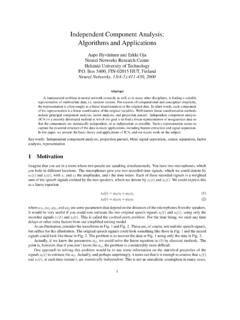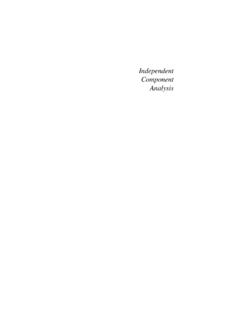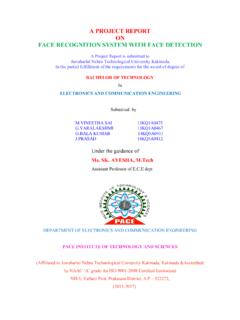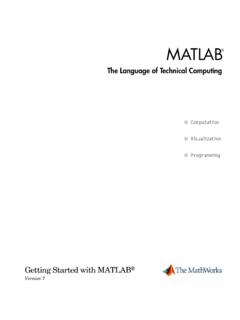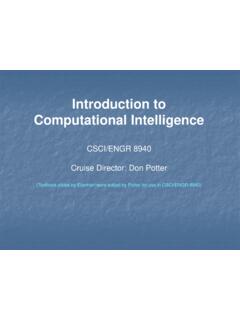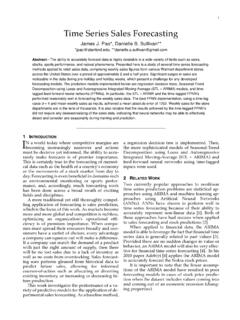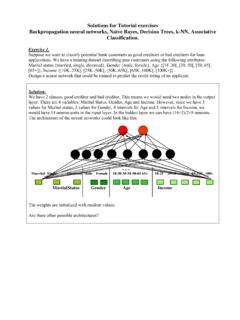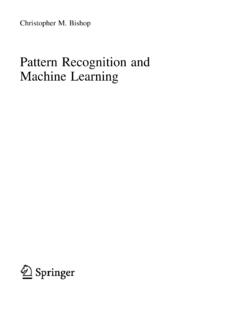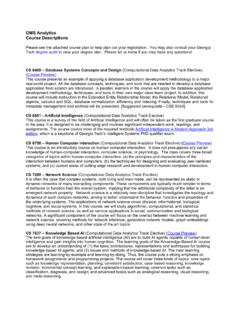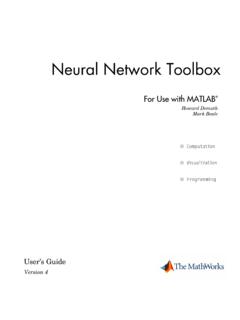Transcription of Introduction to Bioinformatics - University of Helsinki
1 Introduction toBioinformaticsEsa Pitk 2008, I Introduction to Bioinformatics , Autumn 2008 Introduction toBioinformaticsLecture 1:Administrative issuesMBI Programme, Bioinformatics coursesWhat is Bioinformatics ?Molecular biology primer3 How to enrol for the course?pUse the registration system of the ComputerScience department: need your user account at the IT department ( ccaccount )pIf you cannot register yet, don t worry: attend thelectures and exercises; just register when you areable to do so4 TeacherspEsa Pitk nen, Department of Computer Science, University of HelsinkipElja Arjas, Department of Mathematics andStatistics, University of HelsinkipSami Kaski, Department of Information andComputer Science, Helsinki University ofTechnologypLauri Eronen, Department of Computer Science, University of Helsinki (exercises)5 Lectures and exercisespLectures: Tuesday and Friday C221pExercises: Tuesday ExactumC221nFirst exercise session on Tue 9 September6 Status & PrerequisitespAdvanced level course at the Departmentof Computer Science, U.
2 Helsinkip4 creditspPrerequisites:nBasic mathematics skills (probability calculus,basic statistics)nFamiliarity with computersnBasic programming skills recommendednNo biology background required7 Course contentspWhat is Bioinformatics ?pMolecular biology primerpBiological wordspSequence assemblypSequence alignmentpFast sequence alignment using FASTA and BLASTpGenome rearrangementspMotif finding (tentative)pPhylogenetic treespGene expression analysis8 How to pass the course?pRecommended method:nAttend the lectures (not obligatory though)nDo the exercisesnTake the course exampOr:nTake a separate exam9 How to pass the course?pExercises give you max. 12 pointsn0% completed assignments gives you 0 points,80% gives 12 points, the rest by linearinterpolationn A completed assignment means thatpYou are willing to present your solution in theexercise sessionandpYou return notes by e-mail to Lauri Eronen (seecourse web page for contact info) describing the mainphases you took to solve the assignmentnReturn notes at latest on Tuesdays exam gives you max.
3 48 points10 How to pass the course?pGrading: on the scale 0-5nTo get the lowest passing grade 1, you need to get atleast 30 points out of 60 maximumpCourse exam: Wed 15 October A111pSee course web page for separate examspNote: if you take thefirstseparate exam, thebest of the following options will be considered:nExam gives you 48 points, exercises 12 pointsnExam gives you 60 pointspIn second and subsequent separate exams, onlythe 60 point option is in use11 LiteraturepDeonier, Tavar ,Waterman: ComputationalGenome Analysis, anIntroduction. Springer,2005pJones, Pevzner: AnIntroduction toBioinformatics Press, 2004pSlides for some lectureswill be available on thecourse web page12 Additional literaturepGusfield: Algorithms onstrings, trees andsequencespGriffiths et al: Introductionto genetic analysispAlberts et al.
4 : Molecularbiology of the cellpLodish et al.: Molecular cellbiologypCheck the course web site13 Questions about administrative &practical stuff?14 Master's Degree Programme inBioinformatics (MBI)pTwo-year MSc programmepAdmission for 2009-2010 in January 2009nYou need to have your Bachelor s degree ready byAugust programme organizersDepartment of Computer Science,Department of Mathematics and StatisticsFaculty of Science, Kumpula Campus, HYLaboratory of Computer andInformation Science, Laboratory ofCS and Engineering,TKKF aculty of Medicine, Meilahti Campus, HYFaculty of BiosciencesFaculty of Agriculture and ForestryViikki Campus, HY16 TKK, OtaniemiHY, MeilahtiHY, KumpulaHY, ViikkiFour MBI campuses17 MBI highlightspYou can take courses from both HY andTKKpTwo biology courses tailored specificallyfor MBIpBioinformatics is a new exciting field.
5 Witha high demand for experts in job marketpGo to tofind out what a bioinformatician could dofor living18 AdmissionpAdmission requirementsnBachelor s degree in a suitable field ( , computerscience, mathematics, statistics, biology or medicine)nAt least 60 ECTS credits in total in computer science,mathematics and statisticsnProficiency in English (standardized language test:TOEFL, IELTS)pAdmission period opens in late Autumn 2009 andcloses in 2 February 2009pDetails on admission will be posted during this autumn19 Bioinformatics courses in Helsinkiregion: 1st periodpComputational genomics (4-7 credits, TKK)pSeminar: Neuroinformatics (3 credits, Kumpula)pSeminar: Machine Learning in Bioinformatics (3credits, Kumpula)pSignal processing in neuroinformatics (5 credits,TKK)20A good biology course for computerscientists and mathematicians?
6 PBiology for methodological scientists (8 credits, Meilahti)nCourse organized by the Faculties of Bioscience and Medicinefor the MBI programmenIntroduction to basic concepts of microarrays, medical geneticsand developmental biologynStudy group + book exam in I period (2 cr)nThree lectured modules, 2 cr eachnEach module has an individual registration so you canparticipate even if you missed the first courses in Helsinkiregion: 2nd periodpBayesian paradigm in genetic Bioinformatics (6credits, Kumpula)pBiological Sequence Analysis (6 credits, Kumpula)pModeling of biological networks (5-7 credits, TKK)pStatistical methods in genetics (6-8 credits,Kumpula)22 Bioinformatics courses in Helsinkiregion: 3rd periodpEvolution and the theory of games (5 credits, Kumpula)pGenome-wide association mapping (6-8 credits, Kumpula)pHigh-Throughput Bioinformatics (5-7 credits, TKK)pImage Analysis in Neuroinformatics (5 credits, TKK)pPractical Course in Biodatabases (4-5 credits, Kumpula)pSeminar: Computational systems biology (3 credits,Kumpula)pSpatial models in ecology and evolution (8 credits,Kumpula)pSpecial course in Bioinformatics I (3-7 credits, TKK)23 Bioinformatics courses in Helsinki region:4th periodpMetabolic Modeling (4 credits, Kumpula)pPhylogenetic data analyses (6-8 credits,Kumpula)241.
7 What is Bioinformatics ?25 What is Bioinformatics ?pBioinformatics, science ofinformationand information flow in biological systems,esp. of the use of computational methods ingenetics and genomics. (Oxford EnglishDictionary)p"Themathematical,stat isticalandcomputingmethods that aim to solve biological problemsusingDNA and amino acid sequencesandrelated information." -- Fredj Tekaia26 What is Bioinformatics ?p"I do not think all biological computing isbioinformatics, mathematical modelling isnot Bioinformatics , even when connected withbiology-related problems. In my opinion, Bioinformatics has to do withmanagementandthe subsequent use of biological information,particulargenetic information."-- Richard Durbin27 What isnotbioinformatics?
8 PBiologically-inspired computation, , genetic algorithmsand neural networkspHowever, application of neural networks to solve somebiological problem, could be called bioinformaticspWhat about DNA computing? ~lbn/new_ biologypApplication ofcomputingtobiology(broaddefinition)pOf ten used interchangeably with bioinformaticspOr:Biologythat is done withcomputationalmeans29 Biometry & biophysicspBiometry: thestatistical analysisofbiologicaldatanSometimes also the field of identification of individualsusing biological traits (a more recent definition)pBiophysics: "an interdisciplinary field whichapplies techniques from thephysical sciencesto understandingbiological structure andfunction" -- British Biophysical Society30 Mathematical biologypMathematical biology tackles biologicalproblems, but the methodsit uses to tackle them neednot be numerical and neednot be implemented insoftware or hardware.
9 -- Damian CounsellAlan Turing31 Turing on biological complexityp It must be admitted that thebiological exampleswhichit has been possible to give in the present paper can be ascribed quite simply to the fact thatbiological phenomenaare usuallyvery this in combination with the relatively elementarymathematics used in this paper one could hardly expect tofind that many observed biological phenomena would is thought, however, that theimaginary biologicalsystemswhich have been treated, and the principles whichhave been discussed, should be of some help ininterpreting real biological forms. Alan Turing, The Chemical Basis of Morphogenesis, 195232 Related conceptspSystems biologyn Biology of networks nIntegrating different levelsof information tounderstand how biologicalsystems workpComputational systems biologyOverview of metabolic pathways inKEGG database, is Bioinformatics important?
10 PNew measurement techniques producehuge quantities of biological datanAdvanced data analysis methods are needed tomake sense of the datanTypical data sources produce noisy data with alot of missing valuespParadigm shift in biology to utilisebioinformatics in research34 Bioinformatician s skill setpStatistics, data analysis methodsnLots of datanHigh noise levels, missing valuesn#attributes >> #data pointspProgramming languagesnScripting languages: Python, Perl, Ruby, ..nExtensive use of text file formats: needparsersnIntegration of both data and toolspData structures, databases35 Bioinformatician s skill setpModellingnDiscrete vs continuous domainsn-> Systems biologypScientific computation packagesnR, matlab /Octave.




